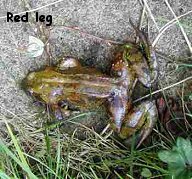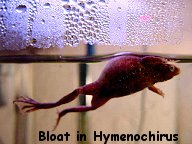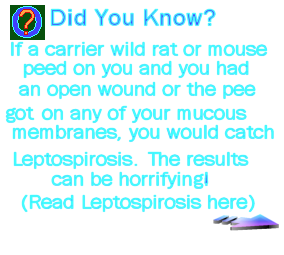Bacterial & Viral Infections
 Bacterial infections are the principal cause of death in frogs and toads.
The responsible bacteria are usually normal
flora found in the natural
places the frogs live. A frog with a weak immune system is more than likely going
to become target for an infection.
The bacteria are usually
gram negative
and include Aeromonas,
Acinetobacter,
Proteus,
Pseudomonas,
and Mima spp.
A formidable virus that is spreading and killing frogs worldwide is the
dreaded Ranavirus.
Bacterial infections are the principal cause of death in frogs and toads.
The responsible bacteria are usually normal
flora found in the natural
places the frogs live. A frog with a weak immune system is more than likely going
to become target for an infection.
The bacteria are usually
gram negative
and include Aeromonas,
Acinetobacter,
Proteus,
Pseudomonas,
and Mima spp.
A formidable virus that is spreading and killing frogs worldwide is the
dreaded Ranavirus.
Red Leg
 Red Leg is the common name for a bacterial septicemia that causes high morbidity/mortality in frogs. Commonly implicated
pathogens are
Aeromonas hydrophila,
Proteus
hydrophilus and
Pseudomonas hydrophilus, also mixed colonies of
Pseudomonas fulva and P. maculicola.
Red Leg is the common name for a bacterial septicemia that causes high morbidity/mortality in frogs. Commonly implicated
pathogens are
Aeromonas hydrophila,
Proteus
hydrophilus and
Pseudomonas hydrophilus, also mixed colonies of
Pseudomonas fulva and P. maculicola.
 These are by no means the only organisms that can cause red-leg. The bacteria that
cause it are normal water flora that seek opportunity to invade the animals when they
have weakened immune systems and/or are stressed. By the time the frogs are
showing signs of the disease, their condition is usually terminal, so please try to
accept that you may not be able to save your frog(s).
These are by no means the only organisms that can cause red-leg. The bacteria that
cause it are normal water flora that seek opportunity to invade the animals when they
have weakened immune systems and/or are stressed. By the time the frogs are
showing signs of the disease, their condition is usually terminal, so please try to
accept that you may not be able to save your frog(s).
Aeromonas hydrophila is found in all freshwater environments, and can infect you through open scratches or wounds when you touch infected water. It can infect any wound, but persons with impaired immune systems due to illness or medication are most susceptible to infection.
Red-Leg is a bacterial disease that occurs in nature, usually in the fall months, September being the most prevalent month of its' arrival. Although usually water borne, the "aeromonas" bacteria can also be found in soil. The entire vivarium or aquarium where the pets resided must be sterilized. To ensure the safety of wild populations, you must avoid waterways at this time, waiting for cooler months or even spring. Don't go out searching for wild frogs now, you may contaminate. Again, instructions for de-contamination are found on the Quarantine page.
 Before treating a frog for redleg, be sure it is in fact redleg.
Tiny herp mites also could be the cause of the redness seen on frogs or toads. Use a magnifying glass and handle the frog with gloves, checking closely on affected areas for the miniscule arachnids. In the case of mite infestation, the reddened areas will be tiny spots,
(the actual mites) and not a solid patch or patches of reddened areas. Click here for treatment of mites.
Before treating a frog for redleg, be sure it is in fact redleg.
Tiny herp mites also could be the cause of the redness seen on frogs or toads. Use a magnifying glass and handle the frog with gloves, checking closely on affected areas for the miniscule arachnids. In the case of mite infestation, the reddened areas will be tiny spots,
(the actual mites) and not a solid patch or patches of reddened areas. Click here for treatment of mites.
So, before treating, make sure you have no cuts, wash your hands and arms with hot soapy water after touching water, or wear elbow-length playtex gloves that you then soak in a salt/bleach sterilize rinse.
Red Leg SymptomsSudden death is very common. In less acute cases, frogs are lethargic and refuse to eat. Sores may be on their skin are often present on the legs and ventral surfaces. Skin discoloration. They may display a slight reddening on the legs and belly. You may also encounter ocular lesions. Swollen body & legs. Skin may turn reddish, especially on the legs. Highly contagious disease, most likely need to treat all in the enclosure. If lesions have appeared, you may be past the time where treatment is successful. Also may have broken blood vessels near the skin surface that are visible to you.
What to do NowHaving already transferred sick frog to Hospital tank, now prepare his medication. If aquatic, soak him in a bath of below mix for 12 minutes each day for 10 days. If your frog is not aquatic, mix 1/2 milligram Baytril to 100 ml water and save in a clean bottle or jar. Using a plastic eyedropper with the treated water, place 1 drop of the medicated water onto the dorsum of frog. DO this each day at the same time, for a total of 10 days. In each case, watch for a complete skin-shedding to verify wellness. Keep him in the hospital tank for 2 weeks after treatment is over for observation. For more on skin-shedding, Click Here.
If you can still get the frog to eat it's feeder insects and while
the above treatment is taking place, soak the frog in a  salt bath as directed once daily.
salt bath as directed once daily.
While treatment is ongoing, the main vivarium or tank must be properly sterilized. Also, after frogs' daily treatment, clean thoroughly the equipment you have used to administer. Both of these issues are addressed on the Quarantine page.
Bloat
See also Intestinal problems
There are two forms of bloat. One cause is created by unicellular flagellates and lungworms. The second type is from improper body metabolism. It could even be the result of an inadequate diet or poor climatic maintenance.
Bloat Symptoms
 If aquatic, the frog's skin seems to be full of liquid, separating it from muscle and causing the
"bloated" appearance that gives this disease it's name. It can be in patchy areas,
or in severe cases, all over the frog's body. The frog's abdomen seems to be
particularly affected.
If aquatic, the frog's skin seems to be full of liquid, separating it from muscle and causing the
"bloated" appearance that gives this disease it's name. It can be in patchy areas,
or in severe cases, all over the frog's body. The frog's abdomen seems to be
particularly affected.
If frog is aquatic, make a Quarantine chamber Bath using 1/2 of a 250 mg. capsule tetracycline or tetramisol, add to 1 cup distilled water, and very small pinch salt. Have the frog soak in this type daily for 5 days, for a time period of 12 minutes. Time It ! Make a fresh bath each day, never use the old bath to re-treat. Dispose of old bath properly, making sure to decontaminate and dry the tupperware after the bath has been disposed of.
After the first five days, switch over to an ampicillin or ampicellix bath for next 5 days, following same mg. and bathing times, amounts, listed above. After 10 days allow the frog to remain in the Quarantine tank for another 2 weeks to make sure infection is gone.
If your frog is not aquatic, make up the same mix as above, cutting the distilled water down to 1/2 cup. With a plastic eyedropper filled with the medicated water, carefully apply 3 drops onto the frogs' dorsum. Follow same treatment length, and use the ampicillin after first 5 days. After the 10 days is up, keep the frog in the hospital tank for another 2 weeks for observation and look for a complete skin-shedding. (For more on skin-shedding, Click Here.
If you can still get the frog to eat it's feeder insects and while the above treatment is taking place; crush a Trisulfa tablet (Made by Mardel labs for fish, in pet shops) with mortar and pestle and dust his feeders with the powder. Feed him these dusted insects every other day throughout his treatment. If not, add 1/8 crushed tablet to the distilled water medication. (This is also listed with red-leg treatment, and will help here too.)
While the treatment is ongoing, you have of course completely sterilized the Main Vivarium or Tank! De-contaminate everything. Instructions are found on the Quarantine page. Don't forget, after frog(s) move back to Main tank, you must sterilize the Hospital tank as well.
Leptospirosis
First off, Leptospirosis is potentially dangerous/fatal to humans! If for even a moment you think your animal has it, NEVER FORGET TO WEAR GLOVES NEAR THIS TANK! MAKE SURE YOU HAVE NO OPEN CUTS OR WOUNDS THAT MAY TOUCH THE FROG OR THE TANK!
 Leptospirosis is a potentially serious bacterial illness that is most common in the
tropics. Leptospirosis can affect many parts of the body. It is an emerging infectious
disease that is under-diagnosed in the United States. The organism enters the body
when mucous membranes or abraded skin comes in contact with contaminated
environmental sources.
Leptospirosis is a potentially serious bacterial illness that is most common in the
tropics. Leptospirosis can affect many parts of the body. It is an emerging infectious
disease that is under-diagnosed in the United States. The organism enters the body
when mucous membranes or abraded skin comes in contact with contaminated
environmental sources.
Leptospirosis is caused by pathogenic spiral bacteria belonging to the genus Leptospira, the family Leptospiraceae, and the order Spirochaetales. These spirochetes are finely coiled, thin, motile, obligate, slow-growing anaerobes. Their flagella allow them to burrow into tissue. The genus Leptospira was originally thought to comprise only 2 species, L. interrogans, which is pathogenic, and L. biflexa, which is saprophytic. There are 7 species of pathogenic leptospires, which appear as more than 250 variants. It is passed in the urine of both domestic and wild animals. In America, most cases occur by transferral of the leptospires from wild rats and mice poop or pee. There is little research at this time on Leptospirosis in anurans.
Leptospirosis SymptomsIn more severe cases, the illness can result in liver damage and jaundice (yellowing of the skin and whites of the eyes), kidney failure, and internal bleeding. What it essentially does is infect the organs listed above and "eats them". Then, of course, they can no longer function. Sadly, this disease is one that in most cases, strikes without you finding out until its too late.
What to do NowHumans DIE from leptospirosis! Because of the potential risk to human life, I strongly suggest that you euthanize it, making sure to wear gloves. Then sterilize (with gloves on) entire tank. Burn and bury the earth in the tank, and the plants. Wash your entire person in antibacterial soap that sits on your skin for at least 30 seconds before touching your hands to any opening in your body, including mouth, eyes, ears, etc. Rinse yourself extra well. Wash towels promptly in strong soap and add bleach to wash-cycle. Dry thoroughly on highest setting in dryer.
If you bought this frog, never buy it from this source again. You may also want to warn them of the potential danger, although it usually does little good with the larger chain pet stores, it's still worth a try. If wild caught, stop catching and bringing home any W. C.'s in your area. Avoid them instead. Find another source for your frog fetish. Lastly, make sure you don't have a rat or mouse issue in or around your home.
Chlamydia
Chlamydia can be transferable to humans.Chlamydia infections can also cause disease in birds, mammals and of course our frogs. C. psittaci can manifest as a respiratory illness in many avian (Bird) species, is highly contagious and can be transmitted to humans and many other mammals. It has been discovered in African clawed frogs. Unless you are very careful and know what your doing, you may be better off with properly (I hate this part guys) euthanizing your pet(s). Be sure to wear gloves during animal's removal from tank, and during treatment. Because it is fungal in nature, and fungus create spores, wearing a painter's mask that you can readily purchase from Home Depot is also a good idea.
Properly disposing of all goods, fluids used is important for you as well as the protection of wild frog species. Please execute the disposals with complete consideration.
SymptomsChlamydia produces signs similar to blood poisoning, but necrosis of the liver, spleen, kidneys, and heart is also present. Chlamydiosis is usually treated, although not always with success, with doxycycline or tetracycline. Tuberculosis can occur sporadically and can be caused by several soil or water-borne organisms such as Mycobacterium xenopi, Mycobacterium marinum, or Mycobacterium ranae. The organism probably gains entry through skin wounds. Nodules and ulcers may be seen on the skin. The disease is preventable with good hygiene.
Chlamydia TreatmentSeparate the affected frog(s) to a Hospital tank. Open a tetracycline or doxycycline capsule and place 1/4 of the powder into 1 cup distilled water. Place mix in a clean jar. Using a plastic eyedropper with the treated mixture, place 3 to 4 drops of the liquid carefully on the frogs' dorsum for 8 days.
Then watch the frog for the next several weeks. After treating the affected frog(s) give them a separate tank away from main population, as a permanent home now. (Chlamydia can return) Look for full skin-sheds, a good sign. (For more on skin-shedding, Click Here.
Repeat the treatment if necessary, but not within a 3 month time frame. Also practice meticulous vivarium house keeping to keep down re-occurrences. Do not introduce any new species, vertebrate or invertebrate, ever; to the tank containing the affected frog!
When animal(s) finally perishes, even of natural causes, give him the proper Funeral treatment.


